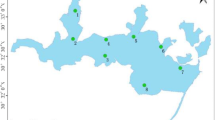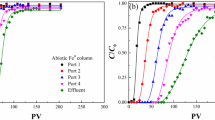Abstract
The Fe/N ratio is an important control on nitrate-reducing Fe(II) oxidation processes that occur both in the aquatic environment and in wastewater treatment systems. The response of nitrate reduction, Fe oxidation, and mineral production to different initial Fe/N molar ratios in the presence of Paracoccus denitrificans was investigated in 132 h incubation experiments. A decrease in the nitrate reduction rate at 12 h occurred as the Fe/N ratio increased. Accumulated nitrite concentration at Fe/N ratios of 2–10 peaked at 12–84 h, and then decreased continuously to less than 0.1 mmol/L at the end of incubation. N2O emission was promoted by high Fe/N ratios. Maximum production of N2 occurred at a Fe/N ratio of 6, in parallel with the highest mole proportion of N2 resulting from the reduction of nitrate (81.2%). XRD analysis and sequential extraction demonstrated that the main Fe minerals obtained from Fe(II) oxidation were easily reducible oxides such as ferrihydrite (at Fe/N ratios of 1–2), and easily reducible oxides and reducible oxides (at Fe/N ratios of 3–10). The results suggest that Fe/N ratio potentially plays a critical role in regulating N2, N2O emissions and Fe mineral formation in nitrate-reducing Fe (II) oxidation processes.

Similar content being viewed by others
References
Aller R C, Heilbrun C, Panzeca C, Zhu Z, Baltzer F (2004). Coupling between sedimentary dynamics, early diagenetic processes, and biogeochemical cycling in the Amazon-Guianas mobile mud belt: Coastal French Guiana. Marine Geology, 208(2–4): 331–360
APHA (2012). Standard Methods for the Examination of Water and Wastewater, 22nd ed. Washington, DC: American Public Health Association
Bryce C, Blackwell N, Schmidt C, Otte J, Huang Y M, Kleindienst S, Tomaszewski E, Schad M, Warter V, Peng C, Byrne J M, Kappler A (2018). Microbial anaerobic Fe(II) oxidation: Ecology, mechanisms and environmental implications. Environmental Microbiology, 20(10): 3462–3483
Buchwald C, Grabb K, Hansel C M, Wankel S D (2016). Constraining the role of iron in environmental nitrogen transformations: Dual stable isotope systematics of abiotic NO2− reduction by Fe(II) and its production of N2O. Geochimica et Cosmochimica Acta, 186: 1–12
Carlson H K, Clark I C, Melnyk R A, Coates J D (2012). Toward a mechanistic understanding of anaerobic nitrate-dependent iron oxidation: Balancing electron uptake and detoxification. Frontiers in Microbiology, 3: 57
Carlson H K, Clark I C, Blazewicz S J, Iavarone A T, Coates J D (2013). Fe(II) oxidation is an innate capability of nitrate-reducing bacteria that involves abiotic and biotic reactions. Journal of Bacteriology, 195(14): 3260–3268
Chakraborty A, Roden E E, Schieber J, Picardal F (2011). Enhanced growth of Acidovorax sp. strain 2AN during nitrate-dependent Fe(II) oxidation in batch and continuous-flow systems. Applied and Environmental Microbiology, 77(24): 8548–8556
Chen D D, Liu T X, Li X M, Li F B, Luo X B, Wu Y D, Wang Y (2018). Biological and chemical processes of microbially mediated nitratereducing Fe(II) oxidation by Pseudogulbenkiania sp. strain 2002. Chemical Geology, 476: 59–69
Chen D D, Yuan X, Zhao W Q, Luo X B, Li F B, Liu T X (2020). Chemodenitrification by Fe(II) and nitrite: pH effect, mineralization and kinetic modeling. Chemical Geology, 541: 119586
Das S, Hendry M J, Essilfie-Dughan J (2011). Transformation of two-line ferrihydrite to goethite and hematite as a function of pH and temperature. Environmental Science & Technology, 45(1): 268–275
Ehrenreich A, Widdel F (1994). Anaerobic oxidation of ferrous iron by purple bacteria, a new type of phototrophic metabolism. Applied and Environmental Microbiology, 60(12): 4517–4526
Grabb K C, Buchwald C, Hansel C M, Wankel S D (2017). A dual nitrite isotopic investigation of chemodenitrification by mineral-associated Fe(II) and its production of nitrous oxide. Geochimica et Cosmochimica Acta, 196: 388–402
Han Z F, Miao Y, Dong J, Shen Z Q, Zhou Y X, Liu S, Yang C P (2019). Enhanced nitrogen removal and microbial analysis in partially saturated constructed wetland for treating anaerobically digested swine wastewater. Frontiers of Environmental Science & Engineering, 13(4): 52
He Q, Zhu Y Y, Li G, Fan L L, Ai H N, Huangfu X L, Li H (2017). Impact of dissolved oxygen on the production of nitrous oxide in biological aerated filters. Frontiers of Environmental Science & Engineering, 11(6): 16
Jamieson J, Prommer H, Kaksonen A H, Sun J, Siade A J, Yusov A, Bostick B (2018). Identifying and quantifying the intermediate processes during nitrate-dependent iron(II) oxidation. Environmental Science & Technology, 52(10): 5771–5781
Klueglein N, Kappler A (2013). Abiotic oxidation of Fe(II) by reactive nitrogen species in cultures of the nitrate-reducing Fe(II) oxidizer Acidovorax sp. BoFeN1- questioning the existence of enzymatic Fe (II) oxidation. Geobiology, 11(2): 180–190
Larese-Casanova P, Haderlein S B, Kappler A (2010). Biomineralization of lepidocrocite and goethite by nitrate-reducing Fe(II)-oxidizing bacteria: Effect of pH, bicarbonate, phosphate, and humic acids. Geochimica et Cosmochimica Acta, 74(13): 3721–3734
Liu T X, Chen D D, Luo X B, Li X M, Li F B (2019). Microbially mediated nitrate-reducing Fe(II) oxidation: Quantification of chemodenitrification and biological reactions. Geochimica et Cosmochimica Acta, 256: 97–115
Ma H, Zhao B Y, Li L, Xie F, Zhou H J, Zheng Q, Wang X H, He J, Lu C W (2019). Fractionation trends of phosphorus associating with iron fractions: An explanation by the simultaneous extraction procedure. Soil & Tillage Research, 190: 41–49
Melton E D, Swanner E D, Behrens S, Schmidt C, Kappler A (2014). The interplay of microbially mediated and abiotic reactions in the biogeochemical Fe cycle. Nature Reviews. Microbiology, 12(12): 797–808
Miot J, Benzerara K, Morin G, Bernard S, Beyssac O, Larquet E, Kappler A, Guyot F (2009a). Transformation of vivianite by anaerobic nitrate-reducing iron-oxidizing bacteria. Geobiology, 7(3): 373–384
Miot J, Benzerara K, Morin G, Kappler A, Bernard S, Obst M, Férard C, Skouri-Panet F, Guigner J M, Posth N, Galvez M, Brown G E Jr, Guyot F (2009b). Iron biomineralization by anaerobic neutrophilic iron-oxidizing bacteria. Geochimica et Cosmochimica Acta, 73(3): 696–711
Miot J, Remusat L, Duprat E, Gonzalez A, Pont S, Poinsot M (2015). Fe biomineralization mirrors individual metabolic activity in a nitratedependent Fe(II)-oxidizer. Frontiers in Microbiology, 6: 879
Muehe E M, Gerhardt S, Schink B, Kappler A (2009). Ecophysiology and the energetic benefit of mixotrophic Fe(II) oxidation by various strains of nitrate-reducing bacteria. FEMS Microbiology Ecology, 70(3): 335–343
Otte J M, Blackwell N, Ruser R, Kappler A, Kleindienst S, Schmidt C (2019). N2O formation by nitrite-induced(chemo)denitrification in coastal marine sediment. Scientific Reports, 9: 10691
Ottley C J, Davison W, Edmunds W M (1997). Chemical catalysis of nitrate reduction by iron(II). Geochimica et Cosmochimica Acta, 61(9): 1819–1828
Picardal F (2012). Abiotic and microbial interactions during anaerobic transformations of Fe(II) and NOx−. Frontiers in Microbiology, 3: 112
Posth N R, Canfield D E, Kappler A (2014). Biogenic Fe(III) minerals: From formation to diagenesis and preservation in the rock record. Earth-Science Reviews, 135: 103–121
Poulton S W, Canfield D E (2005). Development of a sequential extraction procedure for iron: Implications for iron partitioning in continentally derived particulates. Chemical Geology, 214(3–4): 209–221
Pownceby M I, Hapugoda S, Manuel J, Webster N A S, MacRae C M (2019). Characterisation of phosphorus and other impurities in goethite-rich iron ores: Possible P incorporation mechanisms. Minerals Engineering, 143: 106022
Schwertmann U (1991). Solubility and dissolution of iron oxides. Plant and Soil, 130(1–2): 1–25
Sears H J, Spiro S, Richardson D J (1997). Effect of carbon substrate and aeration on nitrate reduction and expression of the periplasmic and membrane-bound nitrate reductases in carbon-limited continuous cultures of Paracoccus denitrificans Pd1222. Microbiology-UK, 143(12): 3767–3774
Sparacino-Watkins C, Stolz J F, Basu P (2014). Nitrate and periplasmic nitrate reductases. Chemical Society Reviews, 43(2): 676–706
Stookey L L (1970). Ferrozine: A new spectrophotometric reagent for iron. Analytical Chemistry, 42(7): 779–781
Straub K L, Benz M, Schink B, Widdel F (1996). Anaerobic, nitrate-dependent microbial oxidation of ferrous iron. Applied and Environmental Microbiology, 62(4): 1458–1460
Thakur I S, Medhi K (2019). Nitrification and denitrification processes for mitigation of nitrous oxide from waste water treatment plants for biovalorization: Challenges and opportunities. Bioresource Technology, 282: 502–513
Vasilaki V, Volcke E I P, Nandi A K, van Loosdrecht M C M, Katsou E (2018). Relating N2O emissions during biological nitrogen removal with operating conditions using multivariate statistical techniques. Water Research, 140: 387–402
Wang M L, Hu R G, Zhao J S, Kuzyakov Y, Liu S R (2016). Iron oxidation affects nitrous oxide emissions via donating electrons to denitrification in paddy soils. Geoderma, 271: 173–180
Watsuntorn W, Ruangchainikom C, Rene E R, Lens P N L, Chulalaksananukul W (2019). Comparison of sulphide and nitrate removal from synthetic wastewater by pure and mixed cultures of nitrate-reducing, sulphide-oxidizing bacteria. Bioresource Technology, 272: 40–47
Weber K A, Achenbach L A, Coates J D (2006). Microorganisms pumping iron: Anaerobic microbial iron oxidation and reduction. Nature Reviews. Microbiology, 4(10): 752–764
Włodarczyk T, Balakhnina T, Matichenkov V, Brzezińska M, Nosalewicz M, Szarlip P, Fomina I (2019). Effect of silicon on barley growth and N2O emission under flooding. Science of the Total Environment, 685: 1–9
Zhang L H, Zheng J, Guo J B, Guan X H, Zhu S Y, Jia Y P, Zhang J, Zhang X Y, Zhang H F (2019). Effects of Al3+ on pollutant removal and extracellular polymeric substances (EPS) under anaerobic, anoxic and oxic conditions. Frontiers of Environmental Science & Engineering, 13(6): 85
Zhang M, Zheng P, Li W, Wang R, Ding S, Abbas G (2015). Performance of nitrate-dependent anaerobic ferrous oxidizing (NAFO) process: A novel prospective technology for autotrophic denitrification. Bioresource Technology, 179: 543–548
Zhang M, Zheng P, Wang R, Li W, Lu H F, Zhang J Q (2014). Nitrate-dependent anaerobic ferrous oxidation (NAFO) by denitrifying bacteria: A perspective autotrophic nitrogen pollution control technology. Chemosphere, 117: 604–609
Zhao L D, Dong H L, Kukkadapu R, Agrawal A, Liu D, Zhang J, Edelmann R E (2013). Biological oxidation of Fe(II) in reduced nontronite coupled with nitrate reduction by Pseudogulbenkiania sp. Strain 2002. Geochimica et Cosmochimica Acta, 119: 231–247
Zhu-Barker X, Cavazos A R, Ostrom N E, Horwath W R, Glass J B (2015). The importance of abiotic reactions for nitrous oxide production. Biogeochemistry, 126(3): 251–267
Zorgani E A, Cibati A, Trois C (2016). Assessment of a natural iron-based sand for the removal of nitrate from water. Water, Air, and Soil Pollution, 227(7): 249
Acknowledgements
This work was supported by the National Key R & D Program of China (No. 2017YFC0505305) and the Fundamental Research Funds for the Central Universities (No. 2662018JC053).
Author information
Authors and Affiliations
Corresponding author
Additional information
Highlights
• Bacterially-mediated coupled N and Fe processes examined in incubation experiments.
• NO3− reduction was considerably inhibited as initial Fe/N ratio increased.
• The maximum production of N2 occurred at an initial Fe/N molar ratio of 6.
• Fe minerals produced at Fe/N ratios of 1–2 were mainly easily reducible oxides.
Electronic Supplementary material
11783_2020_1366_MOESM1_ESM.pdf
The performance of nitrate-reducing Fe(II) oxidation processes under variable initial Fe/N ratios: The fate of nitrogen and iron species
Rights and permissions
About this article
Cite this article
Cheng, B., Wang, Y., Hua, Y. et al. The performance of nitrate-reducing Fe(II) oxidation processes under variable initial Fe/N ratios: The fate of nitrogen and iron species. Front. Environ. Sci. Eng. 15, 73 (2021). https://doi.org/10.1007/s11783-020-1366-2
Received:
Revised:
Accepted:
Published:
DOI: https://doi.org/10.1007/s11783-020-1366-2




